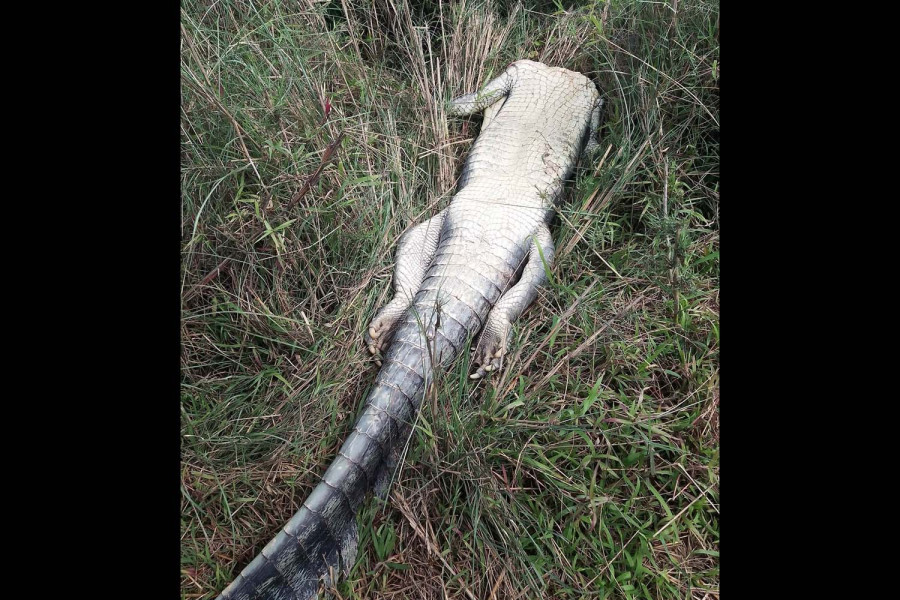Bagmati Province
Tiger mauls gharial to death in Chitwan
Conservationists call it a rare incident. Carcass of the endangered crocodile species was found by a streamside.
Ramesh Kumar Paudel
In a rare incident, a tiger killed a gharial, a critically endangered crocodile species, in Chitwan recently.
Ganesh Prasad Tiwari, assistant conservation and information officer at Chitwan National Park, said the female gharial was found dead on the banks of the Budhi Rapti stream in Baghmara Buffer Zone Community Forest near Sauraha on Tuesday.
Conservationists say the tiger might have attacked the gharial as it surfaced out of the water. “Incidents where a gharial is killed by a tiger is very rare,” said Bed Bahadur Khadka, a retired government conservation officer who has worked in gharial conservation for more than two decades.
Khadka was the chief of the gharial breeding centre that Chitwan National Park established at Kasara in 1978. He used to visit the gharial habitats quite frequently to collect the eggs and keep them in the breeding centre. He said he knows of only two incidents wherein a gharial was killed by a tiger.
Gharials are found in freshwater rivers and streams where human encroachment is low and the number of fish is high. They come out of the water and lay eggs in the sand beds of the river banks. According to Khadka, the gharials start laying eggs from the month of March. He suspected that the tiger attacked and killed the gharial which was protecting its nest on the sand bed.
Jitu Tamang, chairman of Baghmara Buffer Zone Community Forest, said there were prints of tiger’s paws at the incident site. “The gharials set up their nests on the bank of the Budhi Rapti stream,” Tamang said, adding the dead gharial was about 25 years of age.
The gharial has been enlisted as a protected species in Nepal. Conservationists say human activities, river pollution and depletion in the number of fish are the major challenges in gharial conservation. The use of fishing nets, which the Chitwan National Park has banned, is another challenge in gharial conservation in the country. Conservationists say the ban has been effective but it alone is not enough to increase the population of the imperilled species.
According to Tiwari, the latest gharial monitoring, conducted a few months ago, shows that there are 133 gharials in the Rapti river and its tributaries and 106 in the Narayani river. A gharial lives up to 80 years; it starts laying eggs from the age of 15 and continues for about 50 years.
According to Phoebe Griffith, a British researcher who is doing her PhD on gharials, only a very few of them grow up and survive in their natural habitats. In India, for instance, only around one percent of the baby gharials bred in their natural habitats survive, according to studies. But since such studies and research are yet to be conducted in Nepal, the gharial’s survival rate remains unknown. Griffith estimates that around 10 percent of gharials survive in the natural habitats in Nepal.
The last century has been cataclysmic for the gharials of the world. The gharial population, which was estimated to be between 5,000 and 10,000 worldwide during the 1940s, slumped by almost 96 percent to below 200 in 1976. This species—the only surviving member of the Gavialidae family—breeds only in the wild areas of Nepal, India, Bangladesh, Bhutan, Myanmar and Pakistan. The IUCN estimated that the current global gharial population is around 300–900 as of 2020.




 13.12°C Kathmandu
13.12°C Kathmandu1.jpg)











